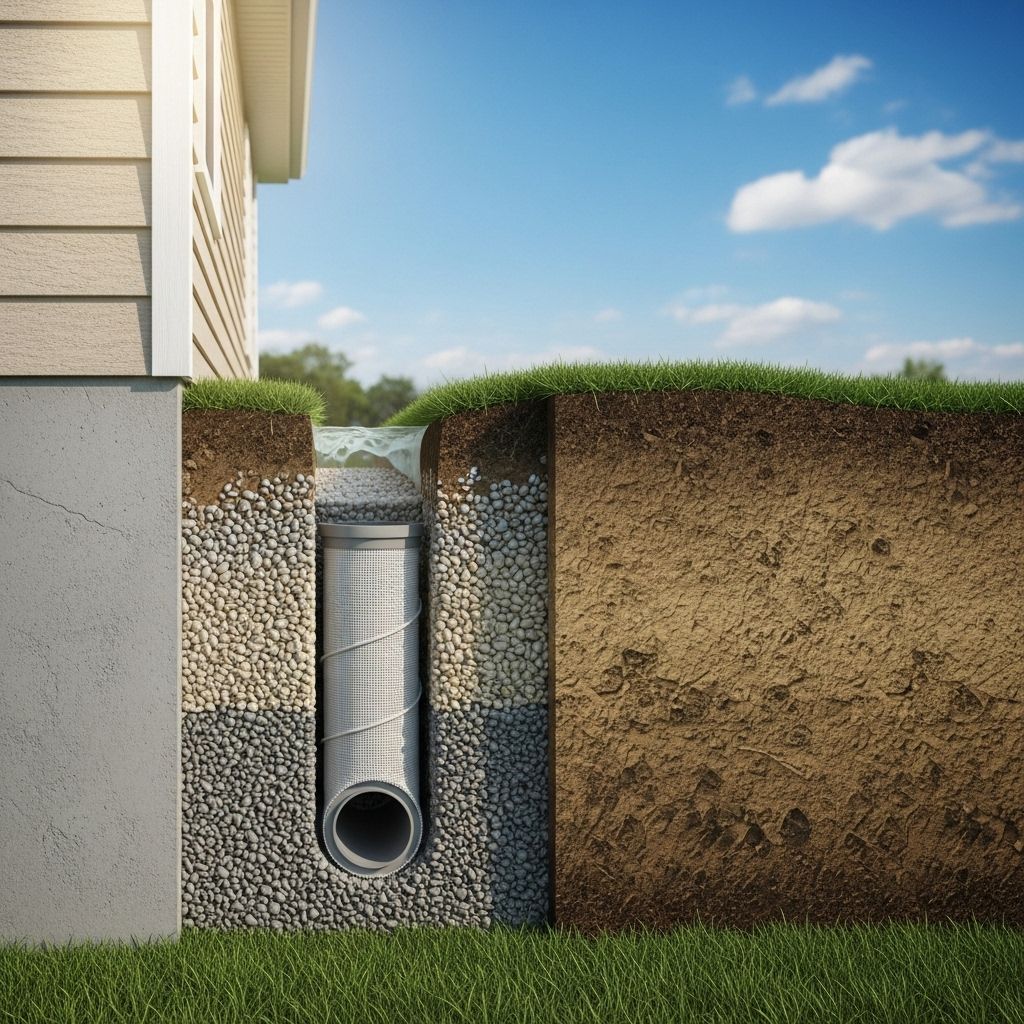French Drain System: 7 Benefits To Protect Your Foundation
Discover how drain tile systems work to keep your basement dry and protect your home's foundation from water damage

Image: HearthJunction Design Team
What Is a Drain Tile System?
A drain tile system, despite its name, rarely involves actual tiles in modern construction. Today’s drain tile systems consist of perforated pipes installed around your home’s foundation to collect and redirect groundwater away from your basement and foundation walls. These systems are crucial for preventing water infiltration that can lead to serious structural damage, mold growth, and a damp basement.
Also commonly called French drains, footing drains, or perimeter drains, these systems work on a simple principle: water follows the path of least resistance. By creating a channel with perforated pipes surrounded by gravel, the system provides an easy path for water to flow away from your foundation rather than pressing against it or seeping into your basement.
How Drain Tile Systems Work
Drain tile systems operate on straightforward but effective principles of water management. As groundwater rises around your foundation, it enters the perforated pipes through small holes or slots. Once inside the pipe, the water flows along the slight gradient of the system, moving away from your foundation either toward a discharge point or a sump pump.
The key components of a drain tile system include:
- Perforated pipes: Usually made of PVC, these pipes contain holes or slots that allow water to enter while keeping soil out
- Gravel or crushed stone: Surrounds the pipe to filter water and create additional drainage paths
- Filter fabric: Wraps around the pipe and gravel to prevent soil and sediment from clogging the system
- Discharge point or sump pump: Determines where the collected water goes once it’s in the system
The beauty of a properly installed drain tile system is that it works automatically and passively in most cases, requiring no electricity or moving parts unless a sump pump is incorporated into the design.
Types of Drain Tile Systems
When protecting your home from water damage, you have two main options for drain tile installation: exterior and interior systems. Each has its advantages and ideal applications.
Exterior Drain Tile
Exterior drain tile systems are installed around the outside perimeter of your foundation, typically at the same depth as the foundation footings. These systems intercept groundwater before it reaches your foundation walls.
The installation process for exterior drain tile involves:
- Excavating the soil around the foundation down to the footings
- Laying a bed of gravel at the bottom of the trench
- Installing perforated pipe along the footings
- Covering the pipe with more gravel
- Wrapping the gravel and pipe with filter fabric
- Backfilling with the excavated soil
Exterior systems are ideal for new construction when the foundation is already exposed, or when addressing severe exterior water issues. They prevent water from ever reaching your foundation walls, which is the most effective approach to waterproofing.
Interior Drain Tile
Interior drain tile systems are installed inside the basement, along the perimeter of the floor where it meets the wall. These systems collect water after it has entered through the foundation but before it can flood your basement.
Installing an interior system typically involves:
- Breaking up the concrete floor around the perimeter of the basement
- Digging a trench along the inside of the footings
- Laying gravel and perforated pipe in the trench
- Connecting the pipe to a sump pump
- Covering the pipe with gravel
- Patching the concrete floor
Interior systems are less disruptive to your landscaping and are often the more practical choice for existing homes. They’re particularly effective when combined with a sump pump system to actively remove collected water.
Signs You Need a Drain Tile System
Your home might be telling you it needs better water management. Here are key indicators that a drain tile system could benefit your property:
- Damp or wet basement: Water stains on walls or floors, or standing water
- Musty odors: Often the first sign of hidden moisture problems
- Visible mold or mildew: Indicates persistent moisture issues
- Efflorescence on walls: White, powdery mineral deposits left behind by evaporating water
- Cracking or bowing foundation walls: Can result from hydrostatic pressure
- Pooling water around your foundation: Indicates poor drainage away from your home
- Flooded basement after heavy rain: A clear sign your current drainage is inadequate
Even if you haven’t experienced flooding, addressing these early warning signs can prevent more serious and costly damage in the future.
Installation Considerations
Installing a drain tile system is a significant project that requires careful planning and execution. Here are key factors to consider before beginning:
DIY vs. Professional Installation
While some experienced DIYers might tackle an exterior drain tile system in non-critical situations, interior systems typically require professional installation. Professionals have the tools, expertise, and knowledge of local building codes to ensure the system works properly and doesn’t compromise your foundation’s structural integrity.
Costs
The cost of a drain tile system varies widely depending on:
- Interior vs. exterior installation
- Size of your home
- Accessibility of your foundation
- Local labor rates
- Additional features (like sump pumps or battery backups)
Interior systems typically range from $3,000 to $8,000 for an average home, while exterior systems can cost between $8,000 and $15,000 or more due to the extensive excavation required.
Permits and Regulations
Most localities require permits for drain tile installation, particularly if you’re altering your foundation or connecting to municipal stormwater systems. Professional contractors will handle this paperwork and ensure compliance with local regulations.
Maintenance and Longevity
A properly installed drain tile system can last for decades with minimal maintenance, but it’s not entirely maintenance-free. Here’s how to ensure your system continues to protect your home:
Regular Maintenance Tasks
- Inspect and clean discharge points annually to ensure they’re not blocked
- Test sump pumps quarterly by pouring water into the sump pit
- Replace sump pump backup batteries every 2-3 years
- Clear surface drains and gutters to prevent overflow that could overwhelm the system
- Monitor for signs of clogs or reduced performance
Common Problems and Solutions
Even well-installed systems can develop issues over time. Watch for:
- Clogged pipes: May require professional hydro-jetting or snaking
- Failed sump pumps: Should be replaced immediately
- Root intrusion: Might require pipe replacement in affected sections
- Collapsed or crushed pipes: Often occurs under driveways or from shifting soil
Having your system inspected by a professional every 3-5 years can catch minor issues before they become major problems.
Benefits of a Drain Tile System
Investing in a drain tile system offers numerous advantages that extend beyond just keeping your basement dry:
- Structural protection: Reduces hydrostatic pressure that can damage foundation walls
- Mold prevention: Eliminates the moisture that mold needs to grow
- Increased usable space: Transforms your basement into dry, functional living area
- Improved indoor air quality: Reduces humidity and musty odors
- Enhanced property value: A dry basement is a significant selling point
- Insurance benefits: May reduce flood insurance premiums
- Peace of mind: Especially during heavy rain or spring thaws
For many homeowners, the initial investment in a quality drain tile system pays dividends through prevented damage and increased home value.
Frequently Asked Questions (FAQs)
Q: How long does a drain tile system last?
A: Modern PVC drain tile systems typically last 30-50 years when properly installed. Older clay tile systems may have shorter lifespans, especially if tree roots have infiltrated the system.
Q: Can I install a drain tile system myself?
A: While exterior systems might be possible for experienced DIYers, interior systems require specialized knowledge and tools. Improper installation can damage your foundation or fail to solve your water problems.
Q: How do I know if my existing drain tile system is working?
A: A functioning system should keep your basement dry even during heavy rains. Signs of failure include water seepage, damp walls, or a constantly running sump pump.
Q: Do drain tile systems require electricity?
A: Passive systems that discharge to daylight don’t require electricity. Systems connected to sump pumps do need power, which is why battery backups are strongly recommended.
Q: Will a drain tile system completely waterproof my basement?
A: While a drain tile system is a key component of basement waterproofing, comprehensive protection typically includes additional measures like exterior waterproofing membranes, proper grading, and functioning gutters and downspouts.
Understanding your drain tile system and maintaining it properly will help ensure your home stays dry and protected for years to come. Whether you’re addressing current water issues or taking preventative measures, a properly installed drain tile system is one of the most effective ways to protect your home’s foundation from water damage.
References
- https://www.youtube.com/watch?v=O5vW4Bog7_c
- https://familydry.com/services/drain-tile-system
- https://www.therealsealllc.com/blog/a-beginners-guide-to-interior-and-exterior-drain-tile-systems/
- https://resconsolutions.com/articles/understanding-your-drain-tile-system/
- https://www.agriculture.com/crops/soil-health/tile-drainage-101
Read full bio of Anjali Sayee












